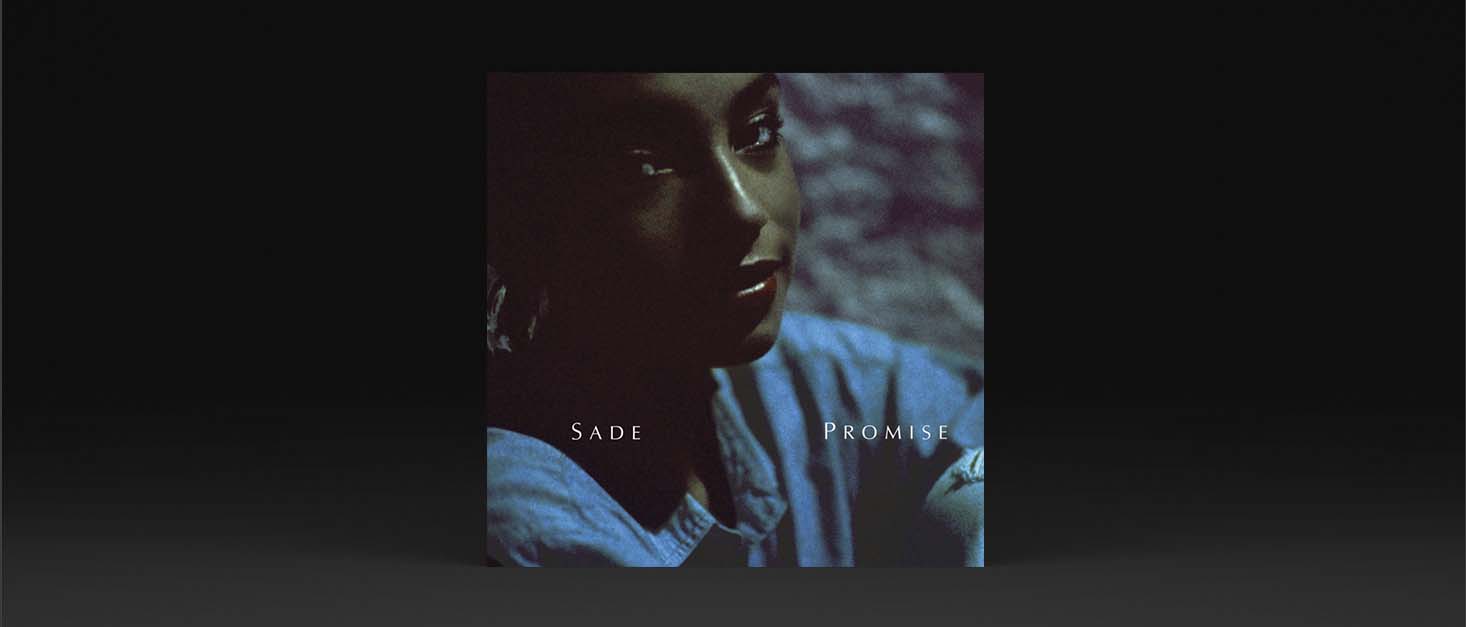
Revisiting Sade's 1985 album, Promise
In the latest in a regular series looking at classic albums from decades past, we examine the distinctive sound of Sade's jazz-infused bestseller
Tags: Music,In the winter of 1983, Helen Fọláṣadé Adu was living in a freezing squatted apartment in Wood Green, North London - an abode that allegedly inspired the now famous lyric, ‘When am I going to make a living, I am hungry but I won’t give in’. Three months later, she was performing on Top of the Pops with her band as Sade. She went on to forge a stellar career as one of the 1980s most distinctive recording artists, beloved by music critics, the public and fashion press.
Born in Nigeria and raised in Clacton-on-Sea, Essex, Sade studied fashion design at Central Saint Martins in London. She worked briefly as a model and menswear designer upon graduating, but soon turned her attention to music, joining the London jazz band Pride in the early 80s, before signing a recording contract with Epic Records in 1983.
At the time, London was buzzing with the energy of the 'New Romantic' scene, celebrated by a wave of savvy and style conscious writers in magazines such as The Face. Bands such as Spandau Ballet and Visage were putting out striking musical compositions, infused with the sounds of a then-new generation of affordable analogue synthesisers. Many of this new wave of acts combined Kraftwerk influences with touches of funk and soul, plus a haute couture style that wouldn’t have looked out of place in a Parisian catwalk show.
"The album was a tremendous success, hitting on the early 80s cultural zeitgeist better than anything else that year"
As a sign of her early business acumen, Sade negotiated a contract with Epic that offered a smaller advance than normal, offset by higher royalties going forward – a testament to the then-24-year-old’s strong self-belief. Her first album, Diamond Life, was released on July 16, 1984, the fruit of a songwriting partnership with former Pride guitarist and saxophonist Stuart Matthewman. It also featured the band’s keyboardist Andrew Hale, bassist Paul Denman and drummer Paul Cook.
The album was a tremendous success, hitting on the early 80s cultural zeitgeist better than anything else that year. While some critics dismissed it as ‘cocktail jazz’ or ‘yuppie soul’, it fused pop with a classy, jazz sensibility, plus an interesting twist. Sade’s vocal style was sultry, measured and introspective, which contrasted US-based ‘soul divas’ of that time. Diamond Life had a simple, smooth, almost ‘indie’ sound, devoid of crooning or other such overblown vocal stylings, plus a tight, workmanlike musical backing. This was enough to give the album’s many strong songs what they needed to shine. The atmospheric ‘Smooth Operator’ became the anthem of 80s nightclubs for years, alongside the more thoughtful ‘Your Love is King’. The album went on to shift over six million copies worldwide, making it the bestselling debut from a British female vocalist, up to that point. The problem was, how to follow it?
Released on November 4, 1985, Promise was again recorded at London’s Power Plant studios, and also Miraval in France. It used the same team of producers as Diamond Life, yet the album felt far more sophisticated, relying more heavily on a brand new generation of digital keyboards which were just making their way into studios. This period was arguably the high watermark of analogue recording, with super quiet mixing desks, microphones and multitrack tape recorders, and relatively few digital effects processors used. The result was an extremely polished sounding production that was absolutely state-of-the-art in 1985.
"The explosion in music making technology was harnessed to full effect with Promise"
It’s a fascinating contrast to Diamond Life, which sounds as if it could have been recorded five or more years earlier, instead of one. The explosion in music making technology was harnessed to full effect with Promise, delivering a sound that was amazing at the time. Nearly 40 years later, it feels somewhat dated, yet charmingly of its time. Production engineered by Mike Pela between February and August 1985, it was co-produced by Pela, Sade, Robin Millar and Ben Rogan. (Pela had previously worked on The Who's Tommy, as well as ELO's Eldorado and Pete Townshend's Scoop.)
The Power Plant's Studio One was a 30x25x18-foot live space, with a 36-channel Harrison mixing console and a 24-track Studer A820 open reel recorder running Ampex tape at 30 inches per second – as fast as it got.
"We had Urei monitors in all of the rooms so that there was some continuity," Pela later recalled. "The band was on tour and performing [album track] ‘Is It A Crime?’, and I thought it was fantastic. A real, epic torch song that clearly communicated these musicians were capable of more. I subsequently thought the new album also had this epic quality, because they were stretching out a bit and some of the songs were longer as well as quite soulful and intimate. The first album had been recorded pretty much live and the second one was too, although we began to use the technology more," he recalled.
"You can hear it chiming away on ‘Is It A Crime?’, its bright, sonorous sound being highly innovative at the time"
Promise was an early example of the practice of using electronic drum pads to trigger percussion samples – here on an Emulator II synthesiser – rather than actual drums. This is common now, but it wasn’t on Diamond Life. An acoustic piano was miked up, and worked with various keyboards including a Fender Rhodes, Emulator II synth and Hammond B3 organ. The band’s first album used the Rhodes a lot, but just a year later, a brand new Yamaha DX7 digital synthesiser largely took its place. “Andrew Hale tended to use this more on Promise just because he could do more with it,” remembers Pela. You can hear it chiming away on ‘Is It A Crime?’, its bright, sonorous sound being highly innovative at the time.
For vocal recording, Sade stood behind a corrugated metal screen at the back of the studio’s control room, singing into a Neumann U87 microphone with a delayed EMT 140 echo plate and dBX 160X compressor. This gave a superb sound to her voice, which was sometimes embellished by an AMS RMX reverb, such as in the middle section of ‘The Sweetest Taboo’.
‘War of the Hearts’ and other tracks used a looping Yamaha RX11 drum machine, something that wasn't even around when Sade was working on her debut. Paul Denman's trademark bass guitar added a strong groove, just as it did on Diamond Life.
"There’s a multitude of other embellishments, such as Matthewman’s great rhythm guitar picking, plus cabasa and sold shaker percussive parts"
“There was no concerted effort to repeat the formula of the first album”, said Pela. “The sound just evolved in the hands of the musicians and without much involvement from the record company. They knew that Sade shied away from obviously commercial material… on this album she and the other musicians were more interested in stretching the songs out and taking the opportunity to play around.”
Promise wouldn’t have been the same without the brass section of Stuart Matthewman on tenor sax, Terry Bailey on trumpet and Pete Beachill on trombone. It counts a lot towards the album’s beautiful texture, and is notable all the way through. There’s a multitude of other embellishments, such as Matthewman’s great rhythm guitar picking, plus cabasa and sold shaker percussive parts that regularly pop up. All this benefitted from the warmth of the Harrison MR3 mixing desk which Pela described as “a lovely, sweet sounding board”. Fascinatingly, he mixed everything to both the Studer open reel tape deck and an early Sony PCM-F1 digital recorder.
"It remains a classy piece of jazz-fused pop"
Promise was perfectly of its era, showcasing Sade’s magnificent and distinctive vocals and canny lyric writing, plus the band’s consummate musicianship. Understandably, it went on to be a big hit, especially in the USA. Its three singles – ‘Is It a Crime?’, ‘Never as Good as the First Time’ and ‘The Sweetest Taboo’ – spent many months in the US Billboard Hot 100 charts.
Some critics weren’t convinced of Sade’s talents – Rolling Stone magazine’s Anthony DeCurtis once opined that “the careful elegance of the production and instrumental settings seems little more than a strategy to conceal the limitations of Sade's vocal range and skills as a song stylist" – but as is so often the case, the buying public begged to differ. The album reached number one on both sides of the Atlantic, plus many other countries too.
As the years have passed, Promise has gone from being perceived as cutting edge to outdated 80s wine bar music. Now, over 35 years later, it makes more sense again, thanks to its period charm. Not only does it timewarp the listener back to a different world of music and culture, it remains a classy piece of jazz-fused pop. Beautifully crafted, its songs, lyrics and of course Sade’s distinctive delivery have an enduring appeal. In the words of Pela: “I think Promise has stood the test of time quite well… [Sade’s] music has always had that timeless kind of feel to it.”














